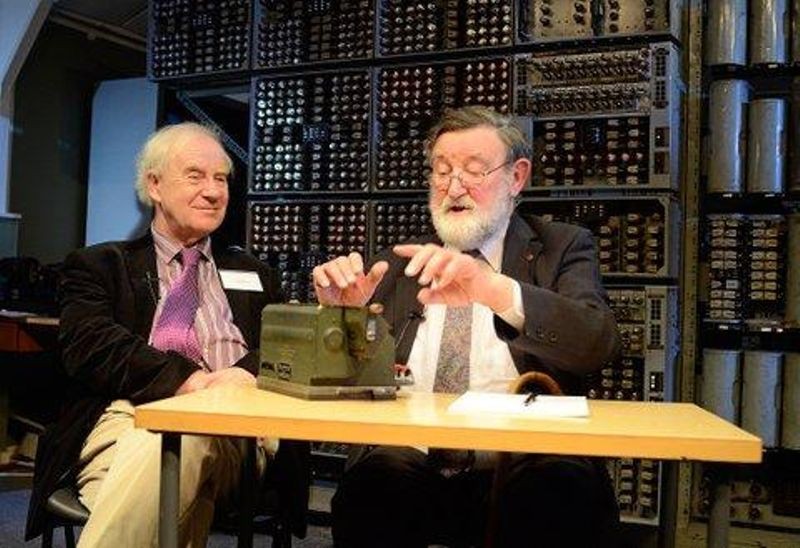
Two months ago, we celebrated the completion of a three-year project to restore the world’s oldest original digital computer back to full working order and to re-assert its place as a Guinness World Record where it was first acknowledged as the world’s most durable computer in 1973. To our surprise and delight, our news went truly global and the short video clip of the event on You Tube went viral.
In our first blogpost for CHM, we thought you’d like some background on the story and to see a video of the Harwell Dekatron / WITCH computer reboot event.
But first, here’s a 50 second taster of the reboot, a video that has since attracted more than one million views on YouTube.
The Harwell Dekatron Computer was developed in the early 1950s at the UK’s centre for atomic energy research, based in the village of Harwell near Oxford. The Atomic Energy Research Establishment had recently been set up and was populated by hundreds of scientists and engineers who were being released from wartime projects, including some of whom were returning from the US Manhattan project.
Engineers in the new electronics division at Harwell developed the new computer, using readily available components and techniques that were well understood, and quickly built an accurate and reliable stored-program computer to aid the teams of mathematicians who were relying on printed tables and mechanical calculators. Speed was very much a secondary consideration, and the machine became know for being slow, but utterly reliable and accurate.
The machine stayed in service at Harwell until 1957, but was saved from destruction and delivered to a college that used the machine to train new engineers and mathematicians until 1975. Again the machine wasn’t lost in 1975, but was put on display in a local museum. As a regular visitor to the museum, I saw the machine many times and had taken photographs and notes.
Sadly that museum closed and the artifacts were broken up and lost to a series of warehouses and storage centers. It had long faded from my memory until 2008 when, by chance, I saw a new photograph that included part of the original control panel from the machine. That chance sighting started the process of tracking down all the remains of the machine and beginning the job of fully understanding its charmed life.

Peter Burden, watches Bart Fossey re-run his ‘race’ with the Harwell Dekatron Computer on Reboot Day.
On 22 November 2012, we gathered together two of the designers of the computer and two early users, along with many guests and visitors, to demonstrate the restored computer working and running an original program. It was the first time the lead designer Ted Cooke-Yarborough had seen the computer working for over sixty years, and when I commented that the machine was running perfectly, Ted dryly replied that ‘it always did’!
Watch the discussion of the Harwell machine with original designers and users, Dick Barnes, Ted Cooke-Yarborough, Bart Fossey, and Peter Burden on YouTube.
The reboot event was also an opportunity to repeat an event from the early life of the computer – a ‘race’ between the machine and one of its users – a story that has grown through re-telling, often with some vivid exaggeration.
In 1952, Harwell mathematician Bart Fossey, equipped with paper, pencils and a Facit mechanical calculator, began a race against the machine with each working on the same problem, Bart using all the mathematical tricks and shortcuts he knew about while the machine plodded on, slowly but surely. The popular story has it that Bart kept up for some time but retired exhausted after 30minutes as the machine carried on remorselessly!
Having the machine restored and Bart, now aged 85, we were able to explain at the reboot event the true story. Bart was testing the calculations done on the computer to check for possible rounding errors as a final check before the machine was put into use on a particular set of problems. Of course, Bart just happened to be doing this at the same time as the machine was performing the same operations, and did indeed keep up for some time. Bart recalled that he was satisfied after 10 minutes that all was well with the computer! Bart and the computer had been calculating at about the same speed. Bart’s boss, it seems, with a fine eye for posterity, went on to embellish the tale.

Peter Burden, an early user at Wolverhampton, Bart Fossey, an early user at Harwell, Kevin Murrell, trustee of TNMOC, plus Dick Barnes and Ted Cooke-Yarborough, two of the three designers of the Harwell Dekatron on Reboot Day.
At the reboot, Bart re-ran the test or ‘race’ and again after some 10 minutes was able to report that all was still well with the computer!
The restored computer is now on permanent display at TNMOC and is regularly demonstrated to visitors to the museum. It is also an integral part in the education program run by the museum for young visitors, who gain a startling insight into the origins of computing.
Lots more information on the Harwell Dekatron / WITCH computer (including the origin of its nickname) can be found at TNMOC.